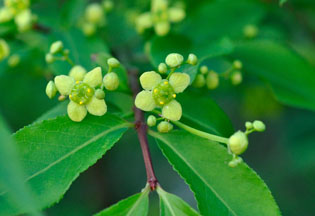WINGED BURNINGBUSH
|
 |
| File Size: 59 KB |
|
|
|
Euonymus alatus (Thunb. ) Siebold
|
| Riley County, Kansas |
| Height: Shrubs, to 6 feet |
| Family: Celastraceae - Staff Tree Family |
| Flowering Period: April, May, June |
|
| Also Called: | | Oriental spindle-tree. | | Trunks: | | Stems erect; bark gray, smooth or furrows shallow, ridge flat; wood white or yellowish white, hard. | | Twigs: | | Green, sometimes tinged purple, rigid, usually 4-angled, usually with 2-4 prominent, irregular brown corky wings, glabrous; leaf scars crescent-shaped; buds green to purplish green or brown, ovoid, .08 to .12 inch, apex acute, scales glabrous. | | Leaves: | | Deciduous, opposite, simple; stipules caducous, linear, .02 to .06 inch; petiole 0 to .08 inch; blade elliptic to oblanceolate, 1 to 3.2 inches long, .2 to 1.2 inches wide, base cuneate to tapered, margins serrulate with teeth strongly incurved, apex acuminate, surfaces green, glabrous. | | Flowers: | | Inflorescences axillary on new growth, flowers 1 or cymes, 2-3-flowered; peduncles .2 to 1.2 inch, glabrous; pedicels .12 to .24 inch, glabrous. Flowers bisexual, radially symmetric; sepals 4, distinct, green, broadly ovate, .02 to .04 inch; petals 4, distinct, greenish yellow, ovate, .08 to .12 inch long, .08 to .12 inch wide; disk obscurely 4-lobed, green; stamens 4; pistil 1, ovary superior, 4-locular, embedded in disk; style absent; stigma entire. | | Fruit: | | July-November; capsules, dark brown to purplish brown, valves deeply lobed nearly to base, often with 1-3 valves aborted, individual valves ovoid, .2 to .28 inch long, .12 to .16 inch, smooth; seed 1 per locule, brown to purplish tan, ellipsoid to nearly globose, .12 to .16 inch long, .08 to .14 inch, smooth; aril orange to yellowish orange, completely surrounding seed. | | Habitat: | | Disturbed woodland and forests, urban woodlots, stream banks, roadsides, old fields, thickets. | | Distribution: | | East 1/3 of Kansas | | Origin: | | Naturalized | | Comments: | | Euonymus alatus is native to eastern Asia. It is a popular ornamental, prized for its bright red to reddish-purple fall foliage and colorful, interesting fruits. Unfortunately, birds consume the fruits and disperse the seeds. It is widely naturalized in the eastern United States and was first documented in the wild in Kansas in 1980. It appears to be spreading rapidly in woodlands in eastern Kansas and should be expected in additional counties. |
|
| Winged burningbush stem wings |  | | 57 KB | | Wildcat Glades, Newton County, Missouri |
| | Winged burningbush leaves |  | | 64 KB | | Wildcat Glades, Newton County, Missouri |
| | Winged burningbush habit |  | | 198 KB | | Wildcat Glades, Newton County, Missouri |
| | Winged burningbush bark |  | | 104 KB | | Riley County, Kansas |
| | Winged burningbush inflorescence |  | | 69 KB | | Wildcat Glades, Newton County, Missouri |
| | Winged burningbush flowers |  | | 55 KB | | Wildcat Glades, Newton County, Missouri |
| | Winged burningbush buds |  | | 31 KB | | Wildcat Glades, Newton County, Missouri |
| | Winged burningbush fruit |  | | 44 KB | | Riley County, Kansas |
| | Winged burningbush fruit |  | | 47 KB | | Riley County, Kansas |
| | Winged burningbush autumn foliage |  | | 63 KB | | Riley County, Kansas |
|
|
|
|